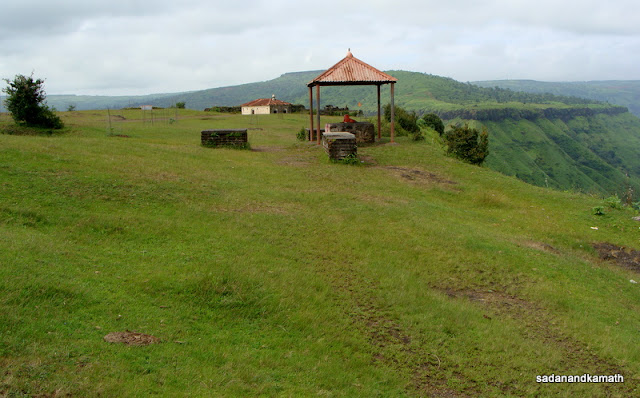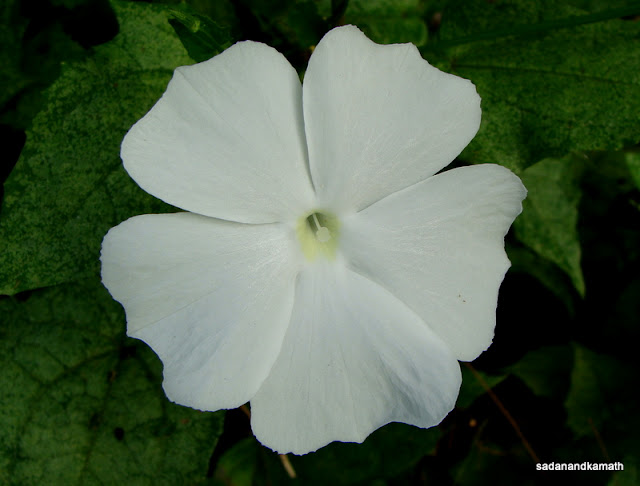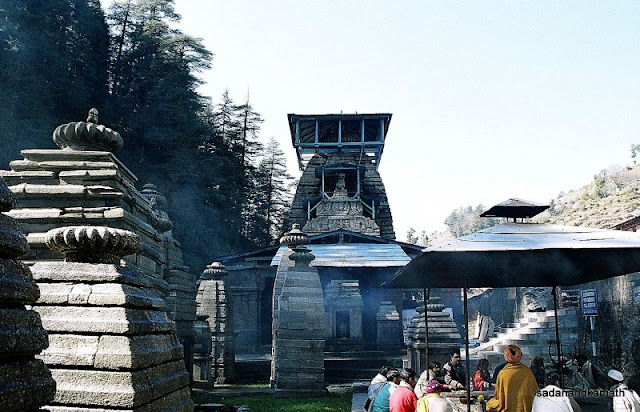We had been to Garhwal many times but barring myself, none of my family members had ever visited Kumaon region. Personally, my exposure to Kumaon was minuscule – having visited only twice - that too for treks to Pindari Glacier (October 1985) and Adi Kailash (Aug-Sept 1993). So it was easier for me to get consensus for a family trip to Kumaon covering Nainital, Mukteshwar, Binsar, Jageshwar and Ranikhet In November 2007 after Diwali.
We left Mumbai by Golden Temple Express to New Delhi and boarded Ranikhet Express from Delhi to reach Kathgodam the next day early morning. We headed for Nainital, our first destination by a pre-booked Scorpio (Rs.500/-) and checked in Hotel Lake View (@Rs.750/- deluxe room) located on the Mall Road. The rooms though small were clean and neat. Being on the upper ridge on the Mall Road, the atmosphere around the hotel was relatively peaceful with good view of Naini Lake from our rooms.. The owner of the hotel who stays in the hotel premises during the tourist season chalked out a revised itinerary for our tours for the next six days making proper sequencing of the trips in an economic way and we readily agreed with his revised schedule.
Day-1 : In Nainital. After breakfast, we were out for a local sight-seeing in an hired Scorpio (Rs.1000/- for full day all inclusive) covering Snow View, Lovers’ Point, Sadiatal Fall, Cave Gardens, Krupatal. After lunch, we spent more time in High Altitude Zoo. A good number of Siberian tigers, leopards, Himalayan bears and snow leopards made the Zoo visit a worthwhile. My 3-year old grand daughter enjoyed the zoo visit the most.
Day-2 : In Nainital. The day started with one hour boating in Naini Lake. The lake looked cleaner than what I had seen in my last visit in October 1985. The areas around the lake are the centre of activities with most of the hotels and restaurants being located on the Mall Road, Tallital and Mallital areas surrounding the Naini Lake. The boat dropped us at Naina Devi temple located at the extreme other end of the lake. The photography inside the temple complex was prohibited though I did not find anything interesting from the photography point of view. After spending a good amount of time for lunch at Chevron Fairhavens at Mallital, we took a taxi to drop us at the starting point of the cable car to Snow View for our repeat visit. The evening was spent in Tibetan Market for an intended window shopping but eventually bought some exotic candles.
Day-3 : Nainital-Mukteshwar-Bhimtal-Naukuchiatal-Sattal-Nainital. We started at 9.00 a.m. for Mukteshwar (54 kms) by an hired Tavera (Rs.2000/- for full day all inclusive). After Bowali, there was a diversion to the right for Mukteshwar via Gagar-Ramgarh-Saragakhet. At Gagar, we got a superb view of the Himalayan peaks. The road condition was excellent except for the last 2 kms rough road. We reached Mukteshwar at 11.00 a.m. and the first visit was to the PWD Rest House from where we got 180 degree clear view of Himalayan peaks – from western Garhwal to some peaks in Nepal. Later, we took a round walk from Mukteshwar temple which was under renovation to Chauli ki Jali, a somewhat dangerous rock cliff from where we had superb views of Ramgarh valley and Almora town. We returned to the temple via a forest path. Mukteshwar is a sleepy town with hardly any people to be seen around. We were the only visitors at the Mukteshwar temple, Chauli ki Jali and Himalayan View Point. Those who wish to spend time in a peaceful atmosphere with Himalayan peaks in constant view, PWD Rest House in Mukteshwar is the place.
From Mukteshwar, we drove to Bhimtal (48 kms) via Saraagakhet-Dhari-Padampur. We reached Bhimtal at around 2.00 p.m. After a quick lunch, we took a walk around Bhimtal before moving to Naukuchiatal (5 kms). After a shikara ride in Naukuchiatal (Rs.150/- for 5 persons), we drove to Sattal (17 kms). Just before Sattal, we had a road side view of Garudtal which was a small lake in the midst of forest. At Sattal, we did not go for boating but preferred enjoying the grandeur of the location. We found Sattal, the best of all lakes around Nainital.In all these places, there were very few visitors. After completion of our lake visit, we returned to Nainital (24kms) by 6.00 p.m. by which time, it was already dusk.
Day-4 : Nainital-Kainchidham-Almora-Binsar (80 kms). We hired a Scorpio for 3 days (Rs.2000/- per day all inclusive except forest entry fee at Binsar Forest Check Post) to cover our travel and sight-seeing plans for the next 3 days and drop back to Nainital. We started from Nainital around 09.30 a.m. for Binsar. On the way, we paid a visit to Kainchi temple (21 kms) and took a tea break at Almora (41 kms). After spending some time on the Mall Road, we commenced our journey to Binsar (18 kms) via Kasar Devi-Kaparkhan. At Binsar forest check post, after which the forest road to Binsar starts, we were required to pay forest entry fee of Rs.40/- per head and the car entry fee of Rs.50/-. We reached Mountain Resort-Khali Estate (@Rs.4200/- AP) at Ayerpani at around 1.30 p.m. After check-in, we had sumptuous Gujarati vegetarian lunch at the Resort’s restaurant. The cottages are situated inside the dense forest cover but all the cottages have Himalayan peak views. Rooms were spacious with rich wooden walls and roofs.. In the afternoon, we went for a forest walk inside the Khali Estate and spent some time in the Resort’s library which had some rare books, mostly relating to travels. These books were donated by the earlier English owners of Khali Estate and also by some of the tourists who stayed in the Resort. Evening was much colder in Binsar than in Nainital and we had to order for heaters to keep our rooms warm.
Day-5 : Binsar-Jageshwar-Almora-Ranikhet (159kms). We got up at 4.30 a.m. and headed for KMVN Rest House (8 kms) to have a sunrise view of the Himalayan peaks from the terrace of KMVN. The lawn leading to the terrace was covered with frost which normally indicates a clear sky. We had a spectacular sunrise view of snow clad peaks. However after sunrise, the smog marred the beauty of the peak view. KMVN with its strategic location seems to be the best place for a peak views in Binsar though one km steep climb to Zero Point would have given us a better comparison of peak view in Binsar. In my view, 180 degree view of the Himalayan peaks from Mukteshwar was a better bet though Binsar (2480m) provided somewhat closure view of the Himalayan peaks from an higher altitude than Mukteshwar (2286m).
We returned to Mountain Resort at 7.30 a.m. After breakfast, we checked out from the Resort at 10.00 a.m. and headed for Jageshwar (55 kms) via Ayerpani-Gairadbend-Paleobend-Barechhina-Punuanaula-Artola. Although a major portion of the journey from Gairadbend to Paleobend was on mud road, it was a smooth ride with hardly any traffic on the road. The journey was more scenic with dense pine forest all along than the normal Almora-Jageshwar route. We reached Jageshwar at 11.30 a.m. The temple complex was situated amidst dense pine forest. Except for some visitors participating in a havan, there were no other tourists. We saw Mrithyunjaya, Jageshwar, Durga, Pushtidevi, Kedarnath and Hanuman temples in Jageshwar temple complex. We were pleasantly surprised that priests in these temples did not pester us for making offerings to gods and for money. After spending about an hour in Jageshwar, we left at 12.30 p.m. to reach Golu Devta temple at Chitai (32 kms) located on Jageshwar-Almora route. Golu is incarnation of Shiva and who is regarded by the people of Kumaon as the dispenser of justice to his devotees in regard to property and personal matters. We found many hand written ‘petitions’ to the Golu Devta, a few on stamp papers as well stick to the temple walls seeking justice. When the justice is done, the devotees offer bells to Golu Devta. A large number of bells hanging in the temple premises seems to suggest that devotees do get fasterr justice from Golu Devta than the courts!
We reached Ranikhet at 4.30 p.m. with a break at Kalika temple and Golf Course. Since golf tournament was in progress, the golf course was out of bound for public and tourists. We checked in Holm Farm Heritage Hotel’s cottages which were smaller as compared with that of Mountain Resort but for a cost, it was value for money (@Rs.1500/- per day EP). From our cottages, we had a good sunset view of the Himalayan peaks followed by a tasty dinner at Hotel’s restaurant.
Day-6 : In Ranikhet and to Nainital. After breakfast, we checked out from the Hotel at 10.00 a.m. and visited Khameshwar and Jhula Devi temples. Our next destination was Choubatia Orchards(10 kms). We took a local guide for one hour to know about the herbal plants inside the Orchards. The walk through the mud path enclosed on both sides by electric fences to ward-off wild animals especially boars was smooth but half-way, the path went through dense forest where there were lots of medicinal and herbal plants. The orchards were mostly barren as it was autumn. The guide told me that the best season for the Orchard visit was April-June when the trees would full of fruits. The one hour of walk ended at a forest produce centre where we had rhododendron flower juice. After a long lunch at Chevron Rosemount, we left Ranikhet at 2.30 p.m. and reached Nainital (65kms) at 4.30 p.m.. After taking some rest in our hotel, we decided to take a stroll on the Mall Road when vehicular traffic is prohibited during 6.00 p.m. to 9.00 p.m. The stroll ended with a good dinner at Alka Hotel. With this, our Kumaon trip came to an end.
Day-7 : Nainital-Kathgodam-Delhi. We left Nainital at 7.00 a.m. by Scorpio (Rs.500/-) and reached Kathgodam railway station within an hourh. We reached Delhi Junction at 4.00 p.m .by Uttaranchal Sampark Kranti Express. After spending 6 hours at the waiting room of New Delhi railway station, we boarded Swaraj Express for Mumbai.
The waiting period at New Delhi railway station provided opportunity to critically appraise our Kumaon trip. We had very good weather throughout the trip. We had good culinary experience in all the places, the best and of course expensive one being at Chevron Rosemount at Ranikhet. Again, we had the good experience of our stays in all the places but our stay at Mountain Resort – Khali Estate at Binsar was the best in terms of its location, vegetarian food, services etc. What we had during our six days of tours were the glimpses of Kumaon and spending 2-3 extra days would have given us opportunity to explore more of places we visited. For instance, in Nainital, we could have one more day to take a walking trips over Thandi Sadak ( Cold Road), Naina peak, Drothy’s seat etc. In Binsar, one extra day would have given us time to ramble through the vast expanse of dense forest for observing flora and fauna. Ranikhet has also some fine walking trails through tall and dense pine forest. But miss out some places in such trips make us to visit these places again.
I am writing this blog nearly after 3 years of our Kumaon visit. While writing our trip report covering Ranikhet, an idea came to my mind for a future trip in Kumaon. It was not Choukori or Munsiary but some less touristy places around Ranikhet such as Sitlakhet, Katarmal Sun Temples, Dwarahat, Dunagiri, Manila and more. As of now, I can see the possibility of such a trip some time in post monsoon period of 2011.
Finally, I have been taking my trek/trip pictures from my faithful Pentex K-1000 since July 1987. However, with ever changing camera technology and some problems with my 28-85mm one-touch zoom lense, I discontinued taking pictures from this camera after our Kumaon trip. Below are some of the last pictures taken by my 20 year long companion K-1000 during our Kumaon trip.

Kathgodam railway station - the gateway to Kumaon.
View from our hotel room, Nainital.
 |
Naini Lake view from our hotel room, Nainital.
|
 |
| Tibetan Market, Nainital. |
 |
| Himalayan peaks view from Snow View Point, Nainital. |
 |
| KMVN's Snow View TRH. |
 |
| High Court Buildings, Nainital. |
 |
Krupatal near Nainital.
|
Himalayan peaks view from Gagar on way to Mukteshwar.
 |
180 degree Himalayan peaks view from Mukteshwar.
 |
A closure view of Himalayan peaks from Mukteshwar.

Shreya, my grand daughter in Mukteshwar.
First rock of Chauli ki Jali in Mukteshwar.
Chauli ki Jali rock in Mukteshwar.
Ramgarh valley seen from Chauli ki Jali.
Way to Mukteshwar temple.
Giant Hanuman in Bhimtal.
Terrace fields in Kaparkhan on way to Binsar.
Binsar Forest Check Post.
Sunset view of Himalayan peaks from Khali Estate, Binsar.
Sunsrise view from KMVN Terrace, Binsar.
Himalayan peaks view from KMVN Terrace, Binsar.
KMVN Terrace. On the left is Tourist Rest House.
The main Jageshwar temple.
One of the cottages of Holm Farm Heritage Hotel, Ranikhet.
Sunset view of Himalayan peaks from Holm Farms Heritage Hotel, Ranikhet.
Holm Farm Heritage Hotel, Ranikhet.
Choubatia Orchards near Ranikhet.
Himalayan peaks view from Choubatia.
Jhula Devi temple, Ranikhet.










































































